
Overland Tech and Travel
Advice from the world's
most experienced overlanders
tests, reviews, opinion, and more
Brown paper packages . . .
. . . tied up with string. This is how your purchase from the Adventure Tool Company arrives. Stylish—and more importantly, it speaks of pride in the contents.

It's no secret I'm a fan of tool rolls for traveling tool kits. They're easy to organize, they don't rattle—a side benefit is that tools stay in better shape if they're not banging around in a box—and they can be stuffed next to other gear without damaging it. Whether you use them on their own, or as sub-organizers inside a larger case, as I often do, they contribute to a smooth work flow when maintenance or repairs are needed in the field.
Happily, high-quality tool rolls seem to be experiencing something of a renaissance. Off Road Trail Tools, after a short hiatus, is back making (in the U.S.) excellent heavy-duty nylon tool rolls in a couple of configurations (here). Bucket Boss makes a couple of decent models, and you can occasionally find others on the web from various companies.
But my favorite tool roll remains the Land Cruiser factory kit I profiled here, made from a stout oiled canvas that fills the air with a heady scent whenever it's opened, reminding me of the surplus military rucksack I first backpacked with, my Barbour jackets, the Australian duster Roseann wears horseback riding. All, you'll note, products of legendary reputation for durability and legendary style.
So when the package from the Adventure Tool Company wafted the same aroma past my nose, I expected good things. And I was not disappointed.

Paul and Amy Carrill started the Adventure Tool Company just two years ago, in Nederland, Colorado, where all their as-yet nascent range of products is produced. They sent me a sample of their ShopRoll tool roll, which is the standard-bearer of a line that so far also includes pouches, a tow-strap throw bag, an intriguing wool camp blanket, and a nifty oiled canvas tarp perfect for protecting the fender of a car you're working on or placing underneath it to lie on.
The ShopRoll is superbly well-made of 12-ounce oiled canvas, with straight stiching and bound edges. Opened up, it's generously sized, as you can see here with a 24mm wrench for scale:

The top flap functions as a place to lay out tools out of the dirt. It's also zippered and forms a huge flattish compartment—into which, I'm told, that canvas tarp folds perfectly. Brilliant. A larger zippered pocket is on the left, and three small flapped pockets on the right. Thirteen variously sized slots take up the center section. Last cunning (and thoughtful) touch - look inside the top flap and you find this:

. . . a tiny pocket with a "busted knuckle" band-aid kit.
So, what does it hold? I got out my Pelican 1550 cased tool kit, which if you've been following along on past posts you'll know is . . . comprehensively . . . equipped. With little trouble, I transferred the following to the ATC roll:

- Wrenches from 8 to 24mm
- 3/8ths ratchet, two extensions
- Shallow sockets from 10 to 24mm, deep sockets from 10 to 15mm
- Three screwdrivers plus an interchangeable bit driver
- A steel and a brass drift and a cold chisel
- Channel-lock pliers
- Vise-grip pliers
- Needle-nose pliers
- Side cutters
- Wire stripper/cutter
- Box knife
- Tin snips
- Hemostat
- Flashlight
- Two hammers
- Hacksaw
I could have stuffed in a bit more, but the ShopRoll took all this easily and rolled tidily. If I were attempting to construct a full kit with the ATC rolls I'd add at least one more, but with the selection I fit in this one I'd feel confident tackling many repairs and maintenance items.
This is a fine piece of gear, and well worth its premium $90 price. I'd like to see ATC add other configurations, especially a dedicated wrench roll with enough slots to actually take a full set of wrenches, unlike virtually every other wrench roll on the market. (That's at least 17 slots, Paul and Amy! Call me and we'll talk . . .) In the meantime, I'd like to add one of those nifty tarps to this kit, then give it some work in the field.

Paul and Amy will be at the 2014 Overland Expo in Flagstaff, Arizona, May 16-18. And I am delighted to announce that they will be producing our custom flapped musette shoulder bags, which everyone who signs up for an Overland Experience package will receive. They'll be our best bags yet.
If you can't wait, the Adventure Tool Company website is here.
Update: ATC has released a very nice motorcycle tool roll:

. . . which would also be useful as a specialty-tool roll to augment the larger one.
Shipping a motorcycle to South America

Reader Matt Caggiano posted this question:
I'm trying to find a reasonable price to air freight my KLR650 from Phoenix AZ to Buenos Aires, Argentina. I was hoping you may have some contacts that can help. I have a Sabbatical from work that starts at the end of February. My plan is to ship my motorcycle to Buenos Aires and then ride home. If I do it right, I'll end the trip at the expo :-)
Thanks so much for any info you can provide!
We surveyed several of our most well-traveled motorcycle correspondents and came up with some possibilities for Matt.
From Alison DeLapp, who's ridden from the U.S. to Ushuaia (alisonswanderland.com):
Javier with Dakar Motos in Buenos Aires is the best, when arranging shipping from BA. Maybe he can help arrange things in reverse for Matt. Dakar Motos
From Ken and Carol Duval (twice around the world on their R80 G/S and still going!):
Greetings from Valle de Bravo, Mexico. We have not used this route but can recommend the shipping section of the Horizons Unlimited site for help: Shipping.
To find a shipping agent we usually just use Yellow Pages or the Internet. Another more direct approach is to ask the airline you intend to fly on if they take cargo like a crated motorcycle. A Dangerous Goods Declaration is required, and the smaller the crate the less you pay, since they charge by volumetric weight. It's always nice to arrive with your bike on the same plane. We have enjoyed this experience a couple of times and it sure takes the stress out of running around a new city trying to get things done.
Ben Slavin, of Motorcycle Mexico, seconded Alison's suggestion about Dakar Motos, and added:
The other option is to buy a bike in Argentina. There are tons of people finishing their trip in Argentina, lots looking to sell their bikes. This thread on ADVrider has bikes for sale in Latin America.
And finally, from Carla King (carlaking.com):
UShip, a crowdsourcing site that reaches professional transport companies and people with pickups, suggests prices and lists your offer in an auction. I was looking to transport a bike I kinda wanted in Texas, but I didn't end up buying it. Still, I had a few good responses, including one individual who regularly traveled between Texas and California in his pickup. He had a great reputation according to reviews on the UShip site. He'd transported motorcycles and boats and boxes of stuff for people, the price was right, and our communication was professional and straightforward. The site had been recommended to me by a friend who has used it, and I liked the experience and would use it again.
23,000-mile review: Klim Latitude jacket and pants
 Pockets galore! (on the Altiplano in Peru)
Pockets galore! (on the Altiplano in Peru)
As a female motorcyclist, choosing a viable suit for long-term riding is met with limited options. Despite the growing industry for women’s gear, what was available in October of 2012 did not equate to the durability and versatility of men’s gear. I looked at comparable manufacturers such as Rev-it and Alpinestars (I rode a KLR, so the BMW brand was not even considered), but neither of those held up to what I wanted out of a suit I was going to live in for six months. So, while preparing for a motorcycle journey from Los Angeles, California to Ushuaia, Tierra del Fuego, I decided on Klim’s Men’s Latitude jacket and pants.
In my initial review after six days of test riding around California before I left, my response was, “Yay! Klim is so great!” But just like any new relationship, I was excited at the potential of what could be, not scrutinizing what I had in front of me. So now, 15-months and more than 23,000 miles later, it’s time to break down the long-term, grime-covered, down and dirty results...
 Latitude 0 (at the Equator in Ecuador)
Latitude 0 (at the Equator in Ecuador)
Continue reading full article here.
Installing an ARB diff lock, part 2
We're back from Silver City, New Mexico, where Bill Lee of Bill's Toy Shop installed an ARB locking differential in the rear of the JATAC (see below for part 1). We've created a 13-minute video detailing the installation and a bit of trail testing afterwards. Watch an ASE Master Technician at work, then see how the increased traction works in the real world - from underneath the truck. Watch it here, or click on the video title for the full HD version on Vimeo.
Installing an ARB diff lock, part 1
 Once you've installed better tires, the number one modification you can do to a four-wheel-drive vehicle to improve traction is to add a differential locker. Lacking traction control or lockers, a four-wheel-drive vehicle is actually only a two-wheel-drive vehicle: In any situation in which one rear tire and one front tire lose traction, the mechanics of an open axle differential mean all the engine's power will be directed to the tires with no grip. Ironic but inevitable. Traction control, which uses the vehicle's anti-lock braking system to apply braking pressure to a spinning wheel, redirects power to the opposite wheel effectively. However, traction-control systems are reactive—they only start working once wheelspin is detected. A manual locker not only distributes torque equally to both tires (which traction control does not), it can also be used proactively, when the driver sees a difficult spot ahead. With just one differential locked, you have increased your available traction by fifty percent. Install a diff lock on a two-wheel-drive vehicle and you've doubled your traction. (See also the comments section on this post.)
Once you've installed better tires, the number one modification you can do to a four-wheel-drive vehicle to improve traction is to add a differential locker. Lacking traction control or lockers, a four-wheel-drive vehicle is actually only a two-wheel-drive vehicle: In any situation in which one rear tire and one front tire lose traction, the mechanics of an open axle differential mean all the engine's power will be directed to the tires with no grip. Ironic but inevitable. Traction control, which uses the vehicle's anti-lock braking system to apply braking pressure to a spinning wheel, redirects power to the opposite wheel effectively. However, traction-control systems are reactive—they only start working once wheelspin is detected. A manual locker not only distributes torque equally to both tires (which traction control does not), it can also be used proactively, when the driver sees a difficult spot ahead. With just one differential locked, you have increased your available traction by fifty percent. Install a diff lock on a two-wheel-drive vehicle and you've doubled your traction. (See also the comments section on this post.)
Our 2012 Tacoma lacks traction control, and we did not get the TRD package, which includes a manual-locking rear differential. So we planned from the start to add one, and the ARB was a natural choice.
Designed by an Australian engineer and four-wheel-drive enthusiast named Tony Roberts, the Roberts Differential was purchased by ARB in 1987. Originally made for the Toyota Land Cruiser, there are now over 100 applications in the ARB catalog. Needless to say it's been well-proven in the field.
The ARB requires an air source to operate, and ARB offers three compressors, from a basic model only suited for that purpose, to a twin-piston design capable of providing a large volume of air. We got the mid-range, single-piston, heavy-duty compressor, which can also inflate tires.
Since I'm a rank rookie on setting up differentials, we plan to have our master mechanic, Bill Lee of Bill's Toy Shop in Silver City, New Mexico, do that job with my assistance (meaning I'll take photos). Besides Roseann's nephew, Jake Beggy, Bill is the only other person we trust implicitly with our vehicles. In the meantime, I installed the compressor and operating switches, and ran the air line to the back axle.
 I had to cut off the clip securing the wiring loom (just left of the bracket) to make room for the compressor's air filter.
I had to cut off the clip securing the wiring loom (just left of the bracket) to make room for the compressor's air filter.
There was exactly one spot in the engine bay of the Tacoma where the compressor would fit. Fortunately it was nearly ideal, and did not impede access to other components. I could have used self-tapping screws to secure its mounting bracket to the sheet metal there, and in all probability they would have been adequate. But I confess to a prejudice against those things—I wanted stainless-steel bolts and nuts. That meant undoing part of the plastic inner fender molding so I could worm one arm up inside the fender to blindly fit and hold a wrench to the nuts once I'd drilled the holes. Two hours of blasphemy and bruising ensued, but eventually it was accomplished.
 The compressor in place, with the quick-release fitting for a tire-inflation hose on top. The black box to its right is the relay. I deemed a self-tapping screw sufficient for that.
The compressor in place, with the quick-release fitting for a tire-inflation hose on top. The black box to its right is the relay. I deemed a self-tapping screw sufficient for that.
The compressor's wiring loom comes in two parts, so there is minimal wiring to push through the firewall. Just four male wiring tabs needed to be pushed through a rubber grommet sealing off the truck's main wiring loom where it passes through to the cab. I taped the tabs to a fat nail normally used as a tent peg, and poked that through the rubber, which seemed to close up satisfactorily around the hole.


With those wires connected to the inside wiring loom, the next task was to mount the switches for the compressor and locker. This can be accomplished easily with the small auxiliary switch panel offered by ARB, which simply screws to the bottom of the dash, but I wanted something that looked a bit cleaner. Two blank switch holes on the left side of the dash offered themselves, and—after some judicious work with a Dremel (would it kill manufacturers to make these holes a universal size?), and some upside-down winkling to get the wires up there—the result was satisfactory.
Next stop: Silver City.

British reserve . . .

I'm reading Valerie Pakenham's book shown above.
She references a letter sent by Joyce Cary, a district commissioner (and later a well-known novelist) in northern Nigeria in 1916. Comparing conditions in his district to those in southern Nigeria, he wrote his wife:
"Northern Nigeria is a paradise compared to those parts. And the people are gentlemen. Not that slaves aren't seized up here and men eaten, but it is done in a polite manner - not obtrusively."
What could I add to that?
Et tu, Filson?
 Lumberjacks well-equipped in early C.C. Filson clothingThe history of exploration in the 20th century is littered with outfitters that got their start and earned fame by offering high-quality, durable clothing and equipment suitable for demanding use in the field, and which then devolved into mere fashion outlets flogging branded urban wear showing little if anything in common with their heritage.
Lumberjacks well-equipped in early C.C. Filson clothingThe history of exploration in the 20th century is littered with outfitters that got their start and earned fame by offering high-quality, durable clothing and equipment suitable for demanding use in the field, and which then devolved into mere fashion outlets flogging branded urban wear showing little if anything in common with their heritage.
Walk into an Abercrombie and Fitch store today and tell a clerk you’d like to be fitted for a new 16-bore sidelock shotgun. You’ll probably find yourself chatting with a policeman in short order. Yet for seven decades A&F was the premier U.S. outfitter for outdoorspeople, whether they were headed out for a weekend of flyfishing or, as one customer and former U.S. President was in 1909, off to Africa for a year of shooting and collecting for the Smithsonian. One could figuratively walk into an A&F store in one’s underwear and leave ready to tackle the Dark Continent. But in 1976 the company declared bankruptcy, and the hallowed name was bought by Oshman’s, which relaunched it as a mail-order shadow of its former self. That was a mild fate compared to the eventual acquisition by The Limited, which has morphed Teddy Roosevelt’s outfitter into . . . well, something he would not recognize.
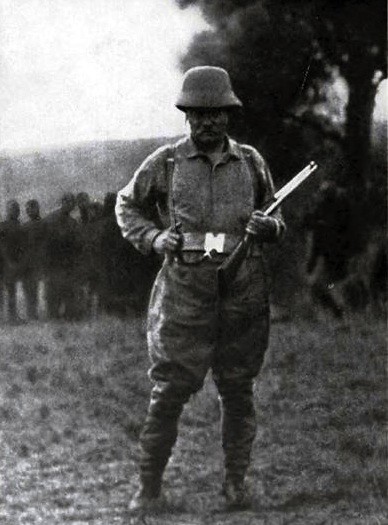 Abercrombie and Fitch, then . . .
Abercrombie and Fitch, then . . . . . . and now.
. . . and now.
There was Willis and Geiger, founded in 1903, who supplied Roald Amundsen, Amelia Earhart, and the Flying Tigers, among many others. When Charles Lindbergh needed a shearling suit for his flight over Antarctica, he turned to W&G, and when Ernest Hemingway wanted a bush jacket made to his own design, he did likewise. I still have several carefully hoarded W&G shirts and bush jackets in their bespoke, tough Bush Poplin.
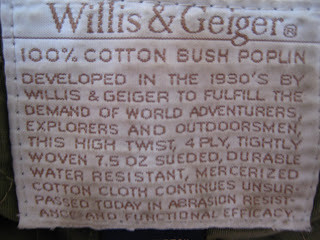
In a twist of fate, W&G was Abercrombie and Fitch’s largest creditor when it filed Chapter 11 (because of branded merchandise), and it did not survive the writeoff. A new owner, Richard Avedon, revived the brand, the products, and the quality, but the writing was on the wall. Various takeovers ensued, production of new items moved offshore until the company was purchased by Lands’ End, which let it fade away ignominiously. (Speaking of which, does anyone here recall that Lands’ End got its start selling foul-weather gear to offshore sailors?)
There are others. Eddie Bauer was a sportsman who patented the quilted down jacket, supplied the military in WWII, and outfitted Jim Whittaker on the first U.S. ascent of Mt. Everest. Once the company was sold in 1968, new corporate owners General Mills turned its focus to everyday clothing and began capitalizing on the evocative name, a marketing assault that hit its nadir when several Ford 4X4 vehicles—and eventually a minivan—received outdoorsy cosmetic packages and were sold as the “Eddie Bauer Edition.” And although Banana Republic’s history dates from just 1978, the company quickly gained a reputation for fine and practical outdoor clothing, only to lose it just as quickly after selling out to Gap Inc.
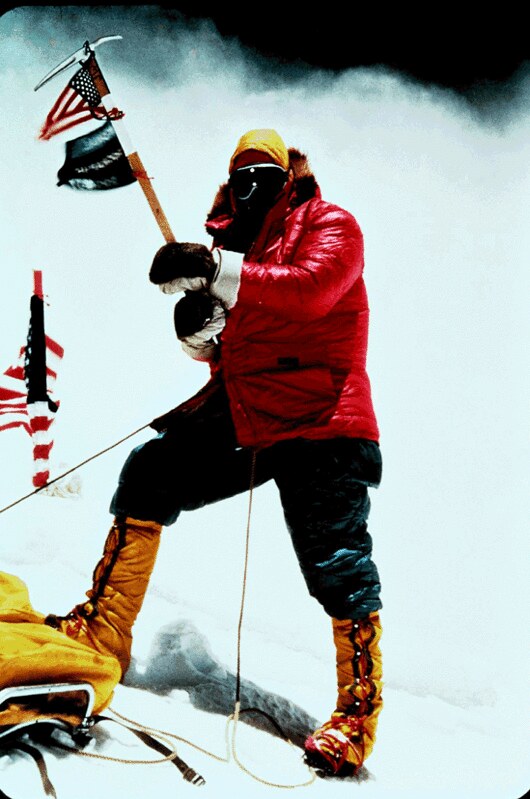 Jim Whittaker atop Mt. Everest, in an Eddie Bauer parka.
Jim Whittaker atop Mt. Everest, in an Eddie Bauer parka.
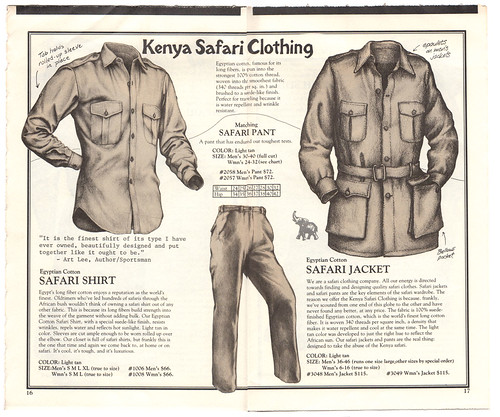 A page from a Banana Republic catalog.
A page from a Banana Republic catalog.
One company weathered all this with standards intact. Clinton C. Filson was born in 1850, homesteaded in Nebraska, then opened a loggers’ outfitting store in Seattle in 1890. In 1897 his business expanded to outfit prospectors on their way to the Alaska gold rush with sleeping bags, boots, and clothing. With the end of the rush, it was natural to shift emphasis to equipping sportsmen with gear for hunting and fishing trips. The family ran the company and the catalog remained small for the next seven decades, until a skiwear manufacturer named Stan Kohls bought the name and expanded the line hugely, while retaining the original design philosophy and maintaining exceptional quality.
This period was arguably the golden age of C.C. Filson. The company produced clothing ranging from heavy-duty outerwear for winter duck hunting to Feathercloth shirts suitable for the hottest African savannah, and luggage seemingly immune to wear. Through the 90s and into the 2000s, Filson shirts became nearly a uniform for me. One medium Filson duffel has made, as near as Roseann and I can figure, 13 trips to Africa between us.
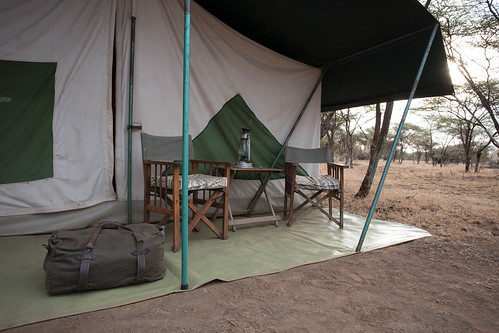 One of our Filson duffels on its . . . 10th? . . . trip to Africa.Sometime around 2005, I noticed some production had shifted offshore. Although the quality remained, to be honest, apparently the equal of the U.S.-made predecessors, prices not only did not drop but began rising to heights at which tearing the sleeve of a Feathercloth shirt on an acacia really hurt. If I’d looked, I would have discovered that at this time Filson had been purchased by a California-based private-equity firm and a former Ralph Lauren executive.
One of our Filson duffels on its . . . 10th? . . . trip to Africa.Sometime around 2005, I noticed some production had shifted offshore. Although the quality remained, to be honest, apparently the equal of the U.S.-made predecessors, prices not only did not drop but began rising to heights at which tearing the sleeve of a Feathercloth shirt on an acacia really hurt. If I’d looked, I would have discovered that at this time Filson had been purchased by a California-based private-equity firm and a former Ralph Lauren executive.
Uh oh.
Still, I remained loyal because the products seemed to stay consistent, they lasted long enough to make the investment worth it, and there was really nothing else I found that I considered equivalent.
Then, a couple of months ago, in preparation for a trip to Kenya, I went to the Filson website to buy a couple of new Feathercloth shirts, steeling myself for the $70-per-shirt hit on my bank account. I found, to my chagrin, that the feathercloth shirt had been discontinued.
No, it was worse—it hadn’t been discontinued, it had been rebranded. It’s now called the “Seattle Shirt”—and the price has doubled magically to $140. Each. So much for a shirt to wear in the bush—clearly this one is no longer intended to risk danger worse than having a latte spilled on it.
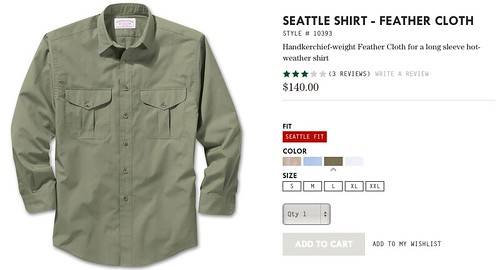 Expedition to Starbucks, anyone?
Expedition to Starbucks, anyone?
A little research reveals a disturbing development: “Filson Holdings” was sold in 2012 to Dallas-based Bedrock Manufacturing, which is backed by the founder of the fashionable accessory manufacturer Fossil. Note that “fashionable accessory” part. As if to confirm my worst fears, it was just this time I happened to catch the news of the “Filson Edition” AEV Brute, a $130,000 customized Jeep pickup outfitted with twill and leather seats (Filson logo prominently displayed), brass trim, and a rear-seat organizer equipped with special Filson bags.
Sigh . . .
It’s actually too early to write off Filson altogether. For example, the company has moved production of many products back to the U.S., a commendable effort. However, the prices of those, and other, items have ballooned so comically that it’s difficult to avoid the conclusion the company is targeting an entirely new customer base—one with whom a name such as “Seattle Shirt” will resonate.
I know I’ll be looking elsewhere for my Kenya shirts.
When I first found the $140 “Seattle Shirt” on the Filson site, I sent an email to the generic Filson customer service email expressing my disappointment, and describing my history with the company’s products in field use ranging from the Arctic to the Sahara. To my surprise, I received an extensive personal reply from a customer service manager named Phil, who assured me that others had written expressing similar opinions, and that all had been forwarded to management.
I later forwarded the original OT&T post above to Phil, along with the comments, as an FYI. Very quickly I received this back from him:
Jonathan,
Thank you for sharing your post and the comments. I read them all and will happily forward this up the food chain to as many people who will read it as I can find. Just a couple comments.
If you will forward the boot guy to me I will take care of him.
You are not the first to mention pricing. Others have and it is an issue management is aware of. As for the AEV Jeep—it is a marvelous machine (we have one here in Seattle) that nobody ever expected to sell many of. I went to see the AEV website and their videos of a similar jeep climbing mountains and such. Very impressive.
I can not answer for everything but I can tell you that many costs, for example that of our Moleskin shirt fabric, have more than doubled recently. Cotton and wool prices have gone way up, as has the price for leather.
Bedrock has been very good for Filson. They have the money to invest in us, which has allowed us to make critical infrastructure and software updates that otherwise would not have been possible. Things such as this allow us to bring more manufacturing back to the USA.
Filson lives for our customers' comments and on their opinions. If we fail to listen to them, we fade away. I will be happy to answer any questions you have as best I can, and please direct your friends to email me here and I will do my best for them.
Thank you,
Phil L
I’ve forgotten how many other companies I’ve written to, with either praise or critique, and received nothing but a toneless boilerplate response, so this is indeed heartening. And Tim (the “boot guy”) will shortly be receiving a new pair of boots. (Phil told him they’d had trouble with the initial supplier of the boots and had switched to a different source.)
It would have been easy for Phil to completely ignore my email, yet he’s not only engaged me several times but has forwarded this thread to others at Filson. So I believe him when he says the company is determined to be responsive to their core customers. But will they need to redefine who that core is?
Consider this wonderful note from the comments section:
Jonathan,
My Dad purchased a Filson upland coat in 1945 upon his return from the war in Europe. It was handed down to me and I've handed it off to my eldest son, grouse blood and all. He still wears it. It's going on 70 and I just turn 70.
Bill
A revealing story regarding Filson quality. But let’s examine it more closely. It should be obvious that Filson can no longer expect to remain profitable by selling upland coats only to grouse hunters such as Bill’s father (or elk hunters such as myself). Hunting is (sadly) in decline in the U.S., although fishing seems to be holding on somewhat better. Much other outdoor activity seems irretrievably wedded to modern technical fabrics (although my Barbour has outlasted several Gore-Tex alternatives). Nevertheless there are many outdoor pursuits besides field sports for which Filson makes superbly suitable clothing—and of course there is their equally superb luggage. I wonder, then, if Filson can defy history and remain true to its heritage, while profiting as much as is necessary from sales to those after nothing but the look. (Random related example: Redwing boots—the orangey-colored moc-toe, eight-inch-tall, white-ripple-sole model beloved of truck drivers, bird hunters, and construction workers—are apparently now the footwear of choice among hip-hop artists. Go figure.)
We’ll stay tuned . . .
An unexpected truck review
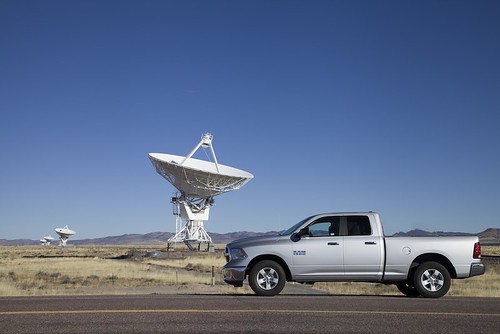 The Ram 1500 in front of the Very Large Array in New Mexico
The Ram 1500 in front of the Very Large Array in New Mexico
Christmas day found Roseann and me driving a rented pickup from Tucson to Cubero, New Mexico, due to an unexpected family situation. We wound up with a 2014 Ram, a two-wheel-drive 1500 Quad-cab (four doors but a slightly smaller rear passenger area than the Crew-cab). I’m always interested to drive new vehicles, and it had been some time since I’d been in a current Ram.
Mostly it was familiar and unremarkable big-truck territory. Plenty of room, a well-organized if ordinary dash and interior. The ride was on the excellent side of very good, as were the seats. But what got my attention was the drivetrain: a 5.7-liter Hemi V8 and a six-speed transmission.
The engine of course had more than enough (395) horsepower, although the “Hemi” hype is a bit misleading. Hemispherical combustion chambers were fairly advanced stuff 50 years ago—in addition to their cross-flow design, the dome-shaped combustion chambers allowed larger intake and exhaust valves to be fitted, and the centrally located spark plug enhanced flame propagation. But the configuration inhibited fuel quench - the turbulence generated when the piston reaches the top of its compression stroke - and thus struggled to achieve complete burn. Modern overhead-cam, multi-valve heads have eclipsed the design in most aspects - power, fuel economy, and emission control—at the expense of complexity and weight, of course.
Nevertheless, Chrysler has made the 5.7 work, using various newer tricks such as variable camshaft timing and variable displacement (cylinder deactivation at highway speeds) to keep it competitive.
The biggest problem with the truck we drove (and of course it was a single example, albeit quite new with fewer than 20,000 miles on it) was that six-speed transmission. Accelerating from a stop at part throttle, there was a massive hesitation between first and second gear; it felt like a manual shift performed by a 15-year-old with a learner’s permit. Floor it to the point of burning rubber and the syndrome went away completely, but one does not want to drive that way all the time, especially in one-streetlight New Mexico towns with bored sheriff deputies hanging around annoyed at having to work the holiday.
Then, once to speed, on any sort of ascent the transmission hunted schizophrenically between ratios, constantly downshifting one gear, two gears—then upshifting again if the grade flattened by one percent, only to drop back down again. Really, I would have thought given 410 lb.-ft. of torque such eager downshifting would be superfluous. I finally began using the manual shift rocker on the lever to hold the truck in one gear on ascents.
However, the tranny foibles were (nearly) forgiven once I tallied the fuel economy for the 1,000-mile journey, which came out to almost exactly 20 miles per gallon. For a 395-horsepower, 5,200-pound pickup on a real-world trip involving lots of mountainous terrain, that’s impressive, and made me think the "Hemi" has some life in it yet. I’m really looking forward to seeing what the Ram’s new 3.0-liter turbodiesel V6 will deliver.
It’s nice to see the American truck makers back at the forefront of innovation in full-size trucks. Ford’s 2015 F150 is set to be a stunning example with its extensive use of aluminum. I can’t help but wonder if Toyota is ever going to step up and do something equally revolutionary with the Tundra.
Hint: When using “Search,” if nothing comes up, reload the page, this usually works. Also, our “Comment” button is on strike thanks to Squarespace, which is proving to be difficult to use! Please email me with comments!
Overland Tech & Travel brings you in-depth overland equipment tests, reviews, news, travel tips, & stories from the best overlanding experts on the planet. Follow or subscribe (below) to keep up to date.
Have a question for Jonathan? Send him an email [click here].
SUBSCRIBE
CLICK HERE to subscribe to Jonathan’s email list; we send once or twice a month, usually Sunday morning for your weekend reading pleasure.
Overland Tech and Travel is curated by Jonathan Hanson, co-founder and former co-owner of the Overland Expo. Jonathan segued from a misspent youth almost directly into a misspent adulthood, cleverly sidestepping any chance of a normal career track or a secure retirement by becoming a freelance writer, working for Outside, National Geographic Adventure, and nearly two dozen other publications. He co-founded Overland Journal in 2007 and was its executive editor until 2011, when he left and sold his shares in the company. His travels encompass explorations on land and sea on six continents, by foot, bicycle, sea kayak, motorcycle, and four-wheel-drive vehicle. He has published a dozen books, several with his wife, Roseann Hanson, gaining several obscure non-cash awards along the way, and is the co-author of the fourth edition of Tom Sheppard's overlanding bible, the Vehicle-dependent Expedition Guide.



